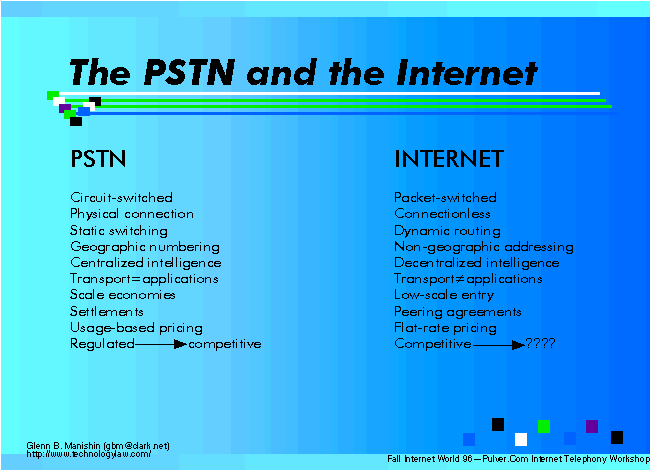
The differences between the Internet and the PSTN are more than a clash of cultures. Each historically uses radically different technologies, architectures and pricing mechanisms. (You may also want to review a schematic drawing of the Internet architecture.)
| PSTN | Internet |
| Circuit-switched | Packet-switched |
| Physical connection | Connectionless |
| Static switching | Dynamic routing |
| Geographic numbering | Non-geographic addressing |
| Centralized intelligence | Decentralized intelligence |
| Transport=applications | Transport not= applications |
| Scale economies | Low-scale entry |
| Settlements | Peering agreements |
| Usage-based pricing | Flat-rate pricing |
| Regulated -> competitive | Competitive -> ???? |
As illustrated by this chart,the regulatory challenge in classifying the Internet using the older models applicable to telecommunications regulation is difficult, at best, and quixotic, at worst. Unlike circuit-switched telecommunications, packet-switched Internet communications "share" bandwidth, so that there is no physical connection between client and host computers. IP addresses are inherently non-geographic. Perhaps most significantly, in the telecom domain, transport and applications are bundled, so that most of the intelligence of the medium resides in the network, while on the Internet intelligence is decentralized, and applications are delivered by client-oriented software. And unlike the "settlements" model applicable to telecommunications, the Internet operates -- with small but significant exceptions -- on a "peering agreement" model, under which usage-sensitive charges are inapplicable to the exchange of traffic between networks.
Regulation must appropriately be tailored to the technology and economics of the medium in question. In light of the dramatic differences between the telecom and Internet paradigms, PSTN-type regulation cannot simply be "ported" to the Internet.
